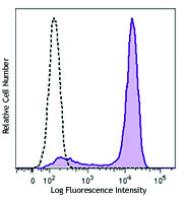-
Sign In
-

-
 Sony Biotechnology
Sony Biotechnology
-

-
 Sony Biotechnology
Sony Biotechnology
Brilliant Violet 605™ anti-mouse CD326 (Ep-CAM)
Antibodies Single
Sony
G8.8
Flow Cytometry
Rat IgG2a, κ
Mouse
TE-71 thymic epithelial cell line
50 µg
1191135
$290.00
Description
EpCAM (CD326) mediates calcium-independent homophilic cell to cell adhesion. It may also function as a growth factor receptor. It is thought to be involved in maintaining cells in position during proliferation. Expression of EpCAM seems to correlate inversely with the level of E-cadherin (CD324). EpCAM is considered important in tumor biology.
Formulation
Phosphate-buffered solution, pH 7.2, containing 0.09% sodium azide and BSA (origin USA).Recommended Usage
Each lot of this antibody is quality control tested by immunofluorescent staining with flow cytometric analysis. For flow cytometric staining, the suggested use of this reagent is ≤0.25 microg per million cells in 100 microL volume. It is recommended that the reagent be titrated for optimal performance for each application.
Brilliant Violet 605™ excites at 405 nm and emits at 603 nm. The bandpass filter 610/20 nm is recommended for detection, although filter optimization may be required depending on other fluorophores used. Be sure to verify that your cytometer configuration and software setup are appropriate for detecting this channel. Refer to your instrument manual or manufacturer for support. Brilliant Violet 605™ is a trademark of Sirigen Group Ltd.
This product is subject to proprietary rights of Sirigen Inc. and is made and sold under license from Sirigen Inc. The purchase of this product conveys to the buyer a non-transferable right to use the purchased product for research purposes only. This product may not be resold or incorporated in any manner into another product for resale. Any use for therapeutics or diagnostics is strictly prohibited. This product is covered by U.S. Patent(s), pending patent applications and foreign equivalents.
References
1. Farr A, et al. 1991. J. Histochem. Cytochem. 39:645. (FC, IHC)
2. Dooley J, et al. 2005. J. Immunol. 175:4331. (FC, IHC)
3. Hinterberger M, et. al. 2010. Nat. Immunol. 11:512. (FC) PubMed
4. Gracz AD, et al. 2010. Am J. Physiol Gastrointest Liver Physiol. 298:590. (IHC) PubMed
5. Nudel I, et al. 2011. J. Immunol. 186:891. PubMed
6. Morimoto H, et al. 2012. Biol Reprod. 86:148. PubMed
7. Ishii K, et al. 2012. Development. 139:1734. PubMed
8. Takehashi M, et al. 2012. Biol Reprod. 86:178. PubMed
9. Murakami R, et al. 2013. PLoS One. 8:73270. PubMed
10. Taguchi K, et al. 2014. Mol Cell Biol. 34:900. PubMed
11. Hirokawa Y, et al. 2014. Am J Physiol Gastrointerest Liver Physiol. 306:547. PubMed
12. Ding X, et al. 2015. Cancer Res. 75:330. PubMed


